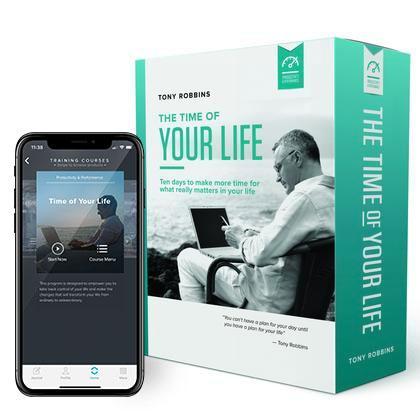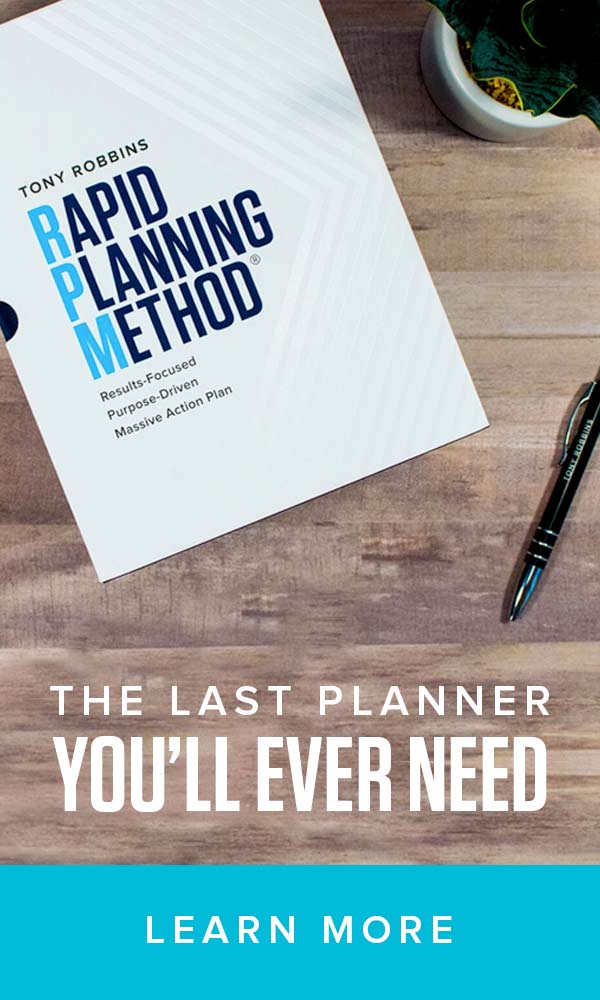Team Tony cultivates, curates and shares Tony Robbins’ stories and core principles, to help others achieve an extraordinary life.
What is productivity, really?
How to improve productivity – and why you should
pro·duc·tiv·i·ty
/ˌprōˌdəkˈtivədē,ˌprädəkˈtivədē/
The classic productivity definition is “a way to measure efficiency.” In an economic context, productivity is how to measure the output that comes from units of input. Farming makes for a good example: One acre of land that produces 10 pumpkins? That’s not very productive. But one acre of land that produces 2,000 pumpkins? That’s a much better return on your pumpkin planting.
But what is productivity in our daily lives? It’s easy to produce theories and examples based on abstract units of work or numbers of plants, but your life isn’t a managed supply chain. To get what you want in life, you need to learn that what makes you productive isn’t a day planner or a to-do list. The art of productivity goes much deeper.
What is productivity?
Writer Charles Duhigg defines productivity as “making certain choices in certain ways” that moves us from being “merely busy” to “genuinely productive” in his book Smarter Faster Better. Tony Robbins’ approach to productivity focuses on ways people can systematize and better manage their lives so they can stop procrastinating and have more time to do what they want.
How do you define productivity? While the end goal for how to be productive in life is personal, productivity is always about getting the results you want with less time and effort. When you’re trying to understand how to be productive, what you’re really seeking is a way to achieve your goals while having time to spend on what matters. “We’re living through an economic revolution,” Duhigg said in an interview on The Tony Robbins Podcast.
Just look at this chart of productivity’s use in print over the past 220 years:
As our economic drivers have shifted, productivity has become an increasingly important concern.
Why is productivity important?
Productivity isn’t just a way to get more done at work – or grow more pumpkins. When you’re thinking, “What is productivity to me? Why do I want to be more productive?,” the most obvious answer that will probably come to mind is that you’ll have more free time to do the things you enjoy doing. If you’re able to reach your goals sooner, that leaves you time to set and achieve other goals, whether that’s relaxing with a book or learning a new skill.
As a bonus, when you accomplish more daily, you’ll see a decrease in life stressors. Rather than running around trying to get everything done, you’ll see your duties completed in a timely manner. In business, you’ll be able to get more done with less – less time, less money and less human capital. When employee productivity rises, you increase efficiency while decreasing costs, ultimately improving your cash flow and revenue.
The difference between movement and productivity
It’s also essential to understand what productivity is not. When you think of someone productive in your life, you may immediately picture a person who is busy all the time. This individual is constantly moving through tasks, pushing deadlines and seemingly trapped under a pile of duties that seems to grow each day. We often equate being busy with being productive, but they aren’t the same thing.
When you unlock the real answer to “What is productivity?,” you won’t be chasing deadlines or running five steps behind on everything you need to get done in a day, week, month or year. Quite the contrary; you’ll probably be ahead of schedule. You won’t feel stressed and anxious about your endless to-do list. You’ll feel on top of the world.
How to be productive in life
We all have 24 hours in a day; productivity is being able to make the most of them and create lasting habits of achievement and fulfillment instead of chasing endless lists of tasks. Here’s how to work smarter, not harder.

1. Discover what makes you productive
What is productivity to you? Why do you want to increase your productivity? Connecting productivity to your passion and purpose in life is the number one way to inspire yourself to take action.
Why have you set those goals in the first place? If you really want to increase your productivity, think about what’s driving you to do so. Sure, you probably want to make more money at your job or be able to go on more vacations, but why? What’s the hunger or purpose that’s driving your actions?
Do you want to be the best version of yourself? Do you want to take better care of your family, your community or the environment? Keeping your ultimate purpose in mind will help steer you, even when the waters get murky.
2. Look to others for productivity in action
We’d all like to succeed with less effort. But how can you calculate productivity, let alone increase it? Your first step is to find some models of what productivity means and what it doesn’t mean to you personally. As Tony says, success leaves clues. Failure does, too.
If your desire to increase your productivity begins at work, model your success after a colleague noted for their productivity. Look for someone who’s got a clear vision for their day, sets limits on their time and even gets projects done early. Ask them how they designed their particular structure and if they’re using any tools. You can start to design your own method based on theirs.
By finding people that embody the type of meaningful productivity that resonates with you, you can start to visualize what makes you productive, both at work and at home.
3. Turn productivity into a habit
It would be nice to say “I’m making a change” and then it just happens with no further effort on your part. But learning how to be productive in life, like any other shift, requires some work on your end. It can take up to three months to form a new habit, whether that’s creating a daily checklist of tasks to guide your day or building out a weekly gym habit.
Once something becomes a habit, it becomes much easier to integrate into a routine. Soon, you realize that a task can become second nature. By turning productivity into a habit, you can achieve far more in your professional and personal life.
4. Get the right tools
Tony tells us that success is 80% psychology and 20% mechanics – but it’s still important to have the right tools in our toolbox. From apps to daily planners, there are plenty of products out there. Tony has used his decades of experience coaching top businesspeople, entrepreneurs and athletes to create his own proven methods for productivity, like:
 The Rapid Planning Method®️ (RPM™)
The Rapid Planning Method®️ (RPM™)
RPM is more than a planner. It’s a whole new way of thinking about your day and your life. Ditch your to-do list and create a compelling vision for your future, then achieve those dreams.
The Time of Your Life®
As Tony says, “You can’t have a plan for your day until you have a plan for your life.” With this ten-day program, you’ll discover what really matters to you – and how to create more time for those things in your life.
Remember, there’s a big difference between movement and achievement; while to-do lists guarantee that you feel accomplished in completing tasks, they don’t ensure that you move closer to your ultimate goals. There are many ways to increase your productivity; the key is choosing the ones that are right for you and your ultimate goals.
As you work toward becoming more productive, you’ll cut down on wasted time and you’ll get back to focusing on what it is you really care about.




